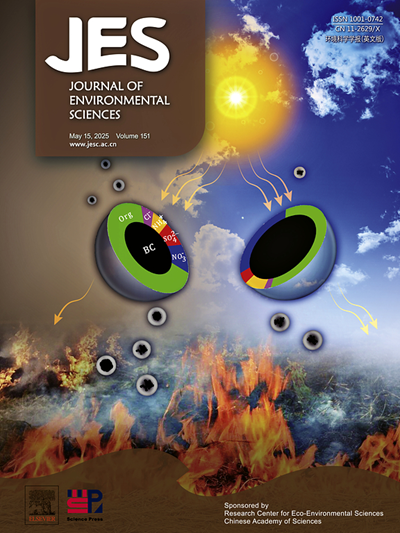长三角地区春季5.6 ~ 560nm颗粒爆炸生长特征及其在人呼吸道中的沉积
IF 5.9
2区 环境科学与生态学
Q1 ENVIRONMENTAL SCIENCES
引用次数: 0
摘要
研究区域输运对超细颗粒物(ufp)的贡献以及纳米级颗粒物在人体呼吸系统中的沉积效应,有助于探索大气颗粒物对环境和人体健康的影响。基于快速迁移粒度仪获取的长三角合肥地区春季5.6 ~ 560nm粒径范围内的数浓度谱数据集,系统研究了ufp的爆炸生长特性、潜在来源识别和沉积通量分析。结果表明,春季新粒子形成(NPF)事件发生频率为31.5%。SO2和O3对NPF事件有贡献。白天、较高的温度、较强的太阳辐射和较低的湿度更有利于ufp的爆发式生长。此外,来自合肥周边城市的污染物的区域输送对颗粒物的积累模式起着重要作用,主要受苏西北陆源气团(23.64%)和黄海海源气团(23.99%)的影响。值得注意的是,每天大约有10406纳克的ufp进入人体呼吸系统。5.6 ~ 560nm纳米级颗粒的主要沉积区域为肺泡,5.6 ~ 400nm更容易沉积在肺泡上,而粒径在400 ~ 560nm之间的纳米级颗粒更容易沉积在头部气道上。本研究确定了不同粒径下纳米级颗粒在呼吸系统中的沉积风险。本文章由计算机程序翻译,如有差异,请以英文原文为准。

Explosive growth characteristics of 5.6–560 nm particles and deposition in human respiratory during spring in Yangtze River Delta region, China
Studying the contribution of regional transport to ultrafine particles (UFPs) and the deposition effect of nanoscale particles in human respiratory system is conducive to exploring the impact of atmospheric particles on the environment and human health. Based on the data set of number concentration spectrum in the particle size range of 5.6–560 nm in the spring of Hefei, the Yangtze River Delta region obtained by a fast mobility particle sizer, the explosive growth characteristics, potential source identification and deposition flux analysis of UFPs were systematically studied. The results showed that the frequency of new particle formation (NPF) events during spring was 31.5 %. SO2 and O3 contribute to NPF events. Daytime, higher temperature, stronger solar radiation and lower humidity were more conducive to the explosive growth of UFPs. In addition, regional transport of pollutants from the cities around Hefei played an important role in the accumulation mode particles, which were mainly affected by the land-source air mass from northwest Jiangsu (23.64 %) and the sea-source air mass from the Yellow Sea (23.99 %). It was worth noting that approximately 10,406 ng of UFPs enters the human respiratory system every day. The main deposition area of 5.6–560 nm nanoscale particles was alveolar, 5.6–400 nm is more likely to be deposited on alveolar, while nanoscale particles with particle size between 400 and 560 nm is more likely to be deposited on head airways. This study identified the deposition risk of nanoscale particles in the respiratory system under different particle sizes.
求助全文
通过发布文献求助,成功后即可免费获取论文全文。
去求助
来源期刊

Journal of Environmental Sciences-china
环境科学-环境科学
CiteScore
13.70
自引率
0.00%
发文量
6354
审稿时长
2.6 months
期刊介绍:
The Journal of Environmental Sciences is an international journal started in 1989. The journal is devoted to publish original, peer-reviewed research papers on main aspects of environmental sciences, such as environmental chemistry, environmental biology, ecology, geosciences and environmental physics. Appropriate subjects include basic and applied research on atmospheric, terrestrial and aquatic environments, pollution control and abatement technology, conservation of natural resources, environmental health and toxicology. Announcements of international environmental science meetings and other recent information are also included.
 求助内容:
求助内容: 应助结果提醒方式:
应助结果提醒方式:


